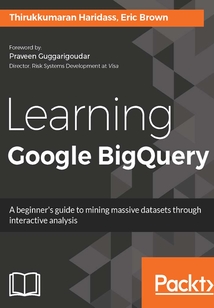舉報(bào) 

會(huì)員
Learning Google BigQuery
最新章節(jié):
Further reading
Ifyouareadeveloper,dataanalyst,oradatascientistlookingtoruncomplexqueriesoverthousandsofrecordsinseconds,thisbookwillhelpyou.NopriorexperienceofworkingwithBigQueryisassumed.
目錄(170章)
倒序
- 封面
- 版權(quán)信息
- Credits
- Foreword
- About the Authors
- About the Reviewers
- www.PacktPub.com
- Why subscribe?
- Customer Feedback
- Dedication
- Preface
- What this book covers
- What you need for this book
- Who this book is for
- Conventions
- Reader feedback
- Customer support
- Downloading the example code
- Errata
- Piracy
- Questions
- Google Cloud and Google BigQuery
- Getting started with Google Cloud
- Overviewing Google Cloud Platform services
- Google Cloud storage and its features
- Learning Google BigQuery
- Working with the browser
- Running your first query
- BigQuery public datasets
- Getting started with Cloud SQL
- Cloud Datastore
- Google App engine
- App engine standard environment
- App engine flexible environment
- Google container engine
- Google compute engine
- Summary
- Google Cloud SDK
- Installing Google Cloud SDK
- Installing Google Cloud SDK on Windows
- Installing Google Cloud SDK on macOS
- Installing Google Cloud SDK on Linux
- gsutil for Google Cloud Storage
- Using the bq utility for BigQuery
- Using the gcloud utility
- Connecting to Cloud SQL using gcloud
- Authorizing the client machine via Google Cloud Console
- Connecting using a proxy script
- Exporting Cloud SQL databases and tables
- Deploying to Google App Engine
- Summary
- Google BigQuery Data Types
- Supported data types
- Data type considerations
- Converting data
- Sanitizing data
- When to transform your data? Before or after loading to BigQuery?
- Arithmetic Operators
- Comparison Operators
- Date Time Functions
- String Functions
- Regular Expression Functions
- Functions for transformation
- Mastering transformation with User-Defined Functions
- Some considerations when using UDFs
- UDF format
- Summary
- Further Reading
- BigQuery SQL Basic
- The BigQuery interface
- Error checking
- Querying in BigQuery
- Types of queries
- Querying public data
- Basic SQL syntax
- Commenting in BigQuery SQL
- SELECT
- FROM
- WHERE
- GROUP BY
- ORDER BY
- HAVING
- Qualifying tables in query
- DISTINCT
- BigQuery SQL functions
- WITHIN
- OMIT RECORD IF
- ROLLUP
- Joining tables in BigQuery
- Inner join
- Left Outer join
- Right Outer join
- Full Outer join
- Cross join
- UNION UNION ALL and UNION DISTINCT
- Adding your own data in BigQuery
- Creating a table
- Inserting data to a table
- Updating data in a table
- Resetting a value
- Deleting data from a table
- Summary
- Further reading
- BigQuery SQL Advanced
- Partition tables
- Creating a partition table using a GUI
- Creating a partition table using Google Cloud SDK
- Querying data in a partition table
- Using partition tables in your projects
- Querying external data sources using BigQuery
- Creating the table definition
- Querying data from external data sources
- Wildcard tables
- User-defined functions
- Views
- Querying nested and repeated records
- Summary
- Further reading
- Google BigQuery API
- Accessing Google BigQuery
- Introducing Google APIs explorer
- Getting credentials for API access
- Creating a service account
- Programming with BigQuery API in C# .NET
- Authenticating the service account
- Listing all datasets and all tables in the project
- Creating a new dataset in the project
- Creating a new table within a dataset
- Loading data from a file in Google Cloud Storage to a BigQuery table
- Executing a query and displaying the result
- Executing the query and saving the result in a new table
- Streaming insert of rows
- Programming with BigQuery API in Python
- Listing all datasets and all tables in the project
- Creating a new dataset in the project
- Creating a new table within a dataset
- Importing data from a file in Google Cloud Storage to a BigQuery table
- Executing a query and displaying the result
- Execute query and copy results to a new table
- Streaming insert of rows
- Roles and permissions
- Summary
- Visualizing BigQuery Data
- Why is data visualization important?
- The danger of summary statistics
- Making data visualization work for you
- Three tools for visualizing BigQuery data
- Simple yet basic – Google Data Studio
- Getting started
- Making a scatterplot in Data Studio
- Making a map in Data Studio
- Other features of Data Studio
- Simple fairly flexible but with a cost – Tableau
- Getting started
- Map charts in Tableau
- Create a word cloud in Tableau
- Complex but with considerable flexibility – the R programming language
- Getting started
- Summary
- Google Cloud Pub/Sub
- Introduction
- Getting started with Cloud Pub/Sub
- Cloud Pub/Sub via Google Cloud Console
- Cloud Pub/Sub via Google Cloud SDK
- Cloud Pub/Sub pricing
- Message output formats
- Importing message data into BigQuery
- Google Cloud Dataprep
- Summary
- Further reading 更新時(shí)間:2021-07-02 21:24:32
推薦閱讀
- Python概率統(tǒng)計(jì)
- Mastering RabbitMQ
- 機(jī)器學(xué)習(xí)系統(tǒng):設(shè)計(jì)和實(shí)現(xiàn)
- Java 9 Programming Blueprints
- 深度強(qiáng)化學(xué)習(xí)算法與實(shí)踐:基于PyTorch的實(shí)現(xiàn)
- 小程序,巧運(yùn)營(yíng):微信小程序運(yùn)營(yíng)招式大全
- Java EE 7 Development with NetBeans 8
- 青少年學(xué)Python(第1冊(cè))
- Python Data Analysis Cookbook
- Integrating Facebook iOS SDK with Your Application
- 面向?qū)ο蟪绦蛟O(shè)計(jì)及C++(第3版)
- 數(shù)字媒體技術(shù)概論
- INSTANT Premium Drupal Themes
- Python數(shù)據(jù)預(yù)處理技術(shù)與實(shí)踐
- Dart:Scalable Application Development
- Visual C#(學(xué)習(xí)筆記)
- Learning Rust
- Visual Basic程序設(shè)計(jì)
- R語言編程基礎(chǔ)
- iOS應(yīng)用逆向工程:分析與實(shí)戰(zhàn)
- Mastering Puppet(Second Edition)
- Professional Azure SQL Database Administration
- AngularJS Deployment Essentials
- EOS區(qū)塊鏈應(yīng)用開發(fā)指南
- 基于Kubernetes的容器云平臺(tái)實(shí)戰(zhàn)
- Node.js Design Patterns(Second Edition)
- Visual Basic編程全能詞典
- 深入淺出:.NET框架設(shè)計(jì)與實(shí)現(xiàn)
- 數(shù)據(jù)庫程序員面試筆試通關(guān)寶典
- Java 9 并發(fā)編程實(shí)戰(zhàn)

